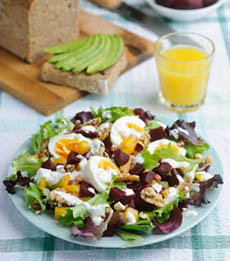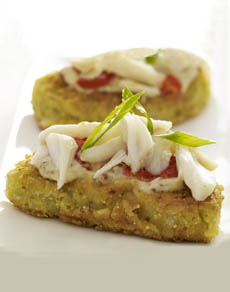|

We’re so happy with these grab-and-go
infused beet snacks and easy salad or side
ingredients. Photo courtesy LoveBeets.com.
|
|
Americans don’t eat enough beets. Love Beets, a packager of cooked beets in several enticing formats, wants to change that.
Growing up in a beet-centric household of Russian descent, we know beets as a truly versatile vegetable that can be enjoyed hot or cold in just about everything—from sandwiches to soup (borscht!) to red velvet cake and ice cream (our beet ice cream was the hit of our 2000 “millennium dinner” on New Year’s Eve).
So our heart fluttered when we discovered Love Beets’ fresh-cooked, ready-to-eat, conveniently designed clamshell packages of beets, with a fork included.
There are also plain cooked beets (conventional or organic) that can be used as a salad or sandwich topper, side dish or healthful snack. There‘s beet juice (delicious!) that can be enjoyed plain, in a smoothie or in a Beet Martini. The line is all natural, gluten free, non GMO and certified kosher by OU.
|
Baby beets are harvested young for a sweeter taste and cooked until tender; then packaged plain or infused with complementary flavors:
Balsamic Infused Beets. A modern take on a traditional flavor, beets are infused with balsamic vinegar, white wine vinegar and a pinch of sugar.
Honey & Ginger Infused Beets. Beets are infused in a blend of white wine vinegar, dark soy sauce, orange blossom honey, ginger purée and a pinch of sugar.
Sweetfire Infused Beets. With a bit of heat, beets are infused in a marinade of wine vinegar, sugar, salt, chili extract and extra virgin olive oil.
Vinegar-Infused Beets. Not quite a pickled beet, the sweetness of these baby beets is complimented by mild vinegar.
Sweetfire Snack Tray. Packaged with white Cheddar cheese cubes and crostini crackers; 129 calories.
|
|
We enjoy the flavor-infused beets straight from the package, or with a side of plain nonfat yogurt—it’s the healthier version of the Russian beets and sour cream.
MORE WAYS TO ENJOY BEETS
Ruby red baby beets add a delicious kick to just about anything.
Add to side salads or luncheon salads. The photo shows a lettuce salad with hard-cooked eggs, crumbled bacon and beets. Add with sliced oranges and beets to lettuce for a new take on a classic Moroccan salad. Arrange with sliced pears, arugula and goat cheese. Our favorite salad: arugula, beets and goat cheese with fresh-snipped dill.
Serve with cold cuts, sandwiches and cheese plates. Take a look at this recipe for Steak Sandwich With Beets & Honey Mustard.
|
|

Add beets to side salads or luncheon salads: here, with hard-cooked eggs and crumbled bacon. Photo courtesy LoveBeets.com.
|
Add sliced beets to a bagel. Slice and layer with smoked salmon and cream cheese. Our diet version: Substitute Greek yogurt for the cream cheese.
Create a beet garnish. Sliced, diced or in matchsticks, beets add pizzazz.
Make beet bruschetta. Layer beets atop sliced baguette, top with Brie or other favorite cheese, heat to slightly melt cheese and garnish with fresh green herbs.
Beet-based dips. It can be as simple as blending beets into plain yogurt with fresh dill. But check out this beet and walnut dip, beet, beet and spinach dip and butterbean hummus and beet and radish chutney.
Return to your roots: Enjoy more beets! Find more delicious beet recipes at LoveBeets.com.
BEET TIPS
You can use cooked beets in any recipe that requires raw beets. Just reduce the cooking time accordingly.
Alas, beet juice does stain. If you aren’t a very neat eater, wear dark clothing! But beet juice is a water-soluble dye, so try one of these methods to clean up stains:
To remove from hands, rub with lemon juice and salt before washing with soap and water
On fabrics, rub a slice of raw pear on the stain before washing or rinse in cold water before washing in detergent.
Use a bleach solution for cutting boards and containers.
THE HISTORY OF BEETS
Beets, or Beta vulgaris, evolved from wild sea beet, which grew wild in places as wide-ranging as Britain and India to Britain. The wild sea beet was first cultivated in the eastern Mediterranean and Middle East—although only the leaves were eaten! (Even today, beet greens are delicious. Don’t throw them away: Sauté them.) In early times, the medicinal properties of the root (the red bulb) led that portion to be used to treat a range of ailments from constipation, fevers, skin problems and wounds.
The Romans cultivated beets; early recipes included cooking beets with honey and wine (that’s still a good recipe today). Apicius, the renowned Roman gourmet, included a beet broth recipe in his cookbook as well as beet salad with a dressing of mustard, oil and vinegar.
The original beet roots were long and thin like carrots. The rounded root shape of today was developedin the 16th century and by the 18th century was widely cultivated in Central and Eastern Europe. Many classic beet dishes originated in this region, including borscht.
In 19th century England, beets’ dramatic color was popular to brighten up salads and soups. The high sugar content made it a popular ingredient in cakes and puddings.
Today there are many varieties of beets sizes large and small, including candy-striped (with red and white concentric circles), orange, white and yellow. Look for these specialty beets in farmers markets.
|
|






